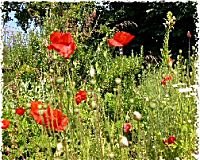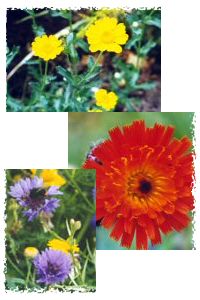

The English Cottage Garden Nursery Ltd.
Eggarton Cottages
Eggarton Lane
Godmersham
Kent CT4 7DY
UK
Not open to the public
 01227 730242 01227 730242

Registered in the UK,
Reg no. 6807584
FERA seed registration number 7258
|

 Payments made online are processed via WorldPay, using 128 bit encryption and secure server
Payments made online are processed via WorldPay, using 128 bit encryption and secure server
|

|
|


|
The Wildflower Meadow
There's almost nothing quite as lovely as a meadow full of wildflowers
and grasses swaying in the summer breeze, butterflies flitting around,
bees buzzing, birds singing and the sun shining. Sadly, though, the
English meadow is rather a rarity, which is bad news for the creatures
that rely on the wildflowers found there. However, every little bit
helps and gardeners can all do their bit to help the butterflies etc
that are reliant on meadow flowers, and, at the same time, also help
preserve a little bit of England. If you are lucky enough to have
a few acres of land you could consider transforming a portion of it
over to meadow. If you have an average sized garden why not apportion,
say, the back area of the lawn over to meadow? Or perhaps create a
meadow area around a focal point such as a statue or bird bath.
You don't need to necessarily create the meadow area from seed either
- unless you are creating quite a large area. You could plant small
pots of wildflowers in an area that is already grassed (as long as
it is not a vigorous-growing rye grass which will smother the plants).
However, when creating a meadow area using this method it is a good
idea to grub out patches of grass and sow Yellow Rattle seed - sprinkle
onto the soil and roll it in. Yellow Rattle is parasitic and relies
on grass for its survival, therefore it is good at controlling grass
growth and allowing more wildflowers to thrive. You could do away
with grass and just plant lots of wildflowers only. If you intend
to create your meadow from seed you need to prepare the seedbed well
by rigorously removing all traces of weeds and raking it to a fine
tilth to receive the seeds. The disadvantage with growing a meadow
from seed is that it will take a couple of years to reach its full
flowering glory, but if you are planning a large meadow then creating
it from seed is the most economical way of doing it. Planting pot-grown
wildflowers gives you an almost instant effect, with most of them
flowering in their first year.
Don't confine yourself, though, to a perennial meadow. You could
create a gorgeous, vibrant meadow full of Cornflowers, Poppies and
Corn Marigolds in the first year of sowing by sowing these annuals
direct onto the prepared soil in April. You can also sow annuals
as a "nurse" crop for a perennial meadow sowing - sow
the annual with the perennial seed and when the annuals germinate
they will help protect the developing perennial plants. After flowering
you simply cut the annuals back, leaving the perennials to carry
on growing. Sowing this way also gives you an almost instant meadow
while waiting the two years for the perennial meadow to start flowering.
Consider also if you want a spring-flowering or summer-flowering
meadow - for spring-flowering you would plant, say, Cowslips and
Fritillaries, and leave the area un-mown until June, when the plants
have died down and set seed. If you plan a summer-flowering meadow
you would leave it unmown until August sometime (when flowering
is over and seed set) and then mow and save the resultant hay. You
could even mow the area again in October before winter sets in.
Whatever you decide to do, it will look great and the local wildlife
will love you for it! We grow many meadow wildflowers in 7 cm and
9 cm pots (such as Ragged Robin, Cowslips, Bladder Campion, Meadow
Clary, to name but a few) which are cheap sizes to plant and can
get you started on your meadow.
Even cheaper to plant are wildflower plugs.
These are available in quantities of 10, 50 or 100 (subject to stock being ready) and can be accessed via the Plugs link on the left.
We also supply meadow seed mixes for a variety
of areas.
How to Create your Meadow
|
| |
|
|
Suitable Wildflowers for Meadows or Meadow Areas
Yarrow, Lesser Knapweed, Wild Carrot, Lady's Bedstraw, Ox-eye Daisy,
Red Campion, Field Scabious, Cowslip, Selfheal, Birds Foot Trefoil,
Raged Robin, Musk Mallow, Bladder Campion, Red Clover, Meadow Cranesbill,
Meadow Clary, Kidney Vetch, Wild Marjoram, Wild Mignonette, Small
Scabious, Toadflax, Viper's Bugloss, Vetch, Yellow Rattle, Corn
Marigold, Corn Chamomile, Poppy, Cornflower, Corncockle
|
|
|
|
|
|
|
wildflowers collection
|
wildflower plants
|
meadow seeds
|
|
|
Keen to attract lots of wildlife to your garden?
Visit our wildlife gardening section for information.
|
|
|
 01227 730242
01227 730242
 Payments made online are processed via WorldPay, using 128 bit encryption and secure server
Payments made online are processed via WorldPay, using 128 bit encryption and secure server



